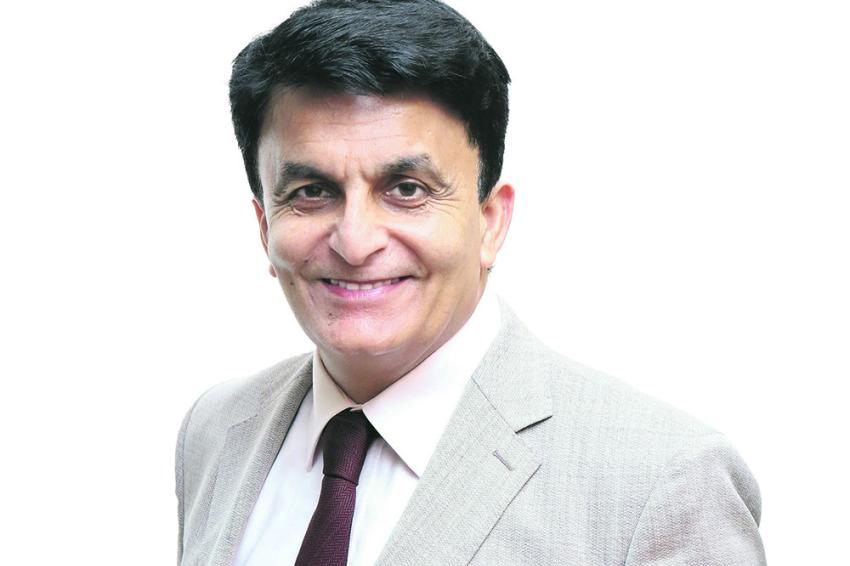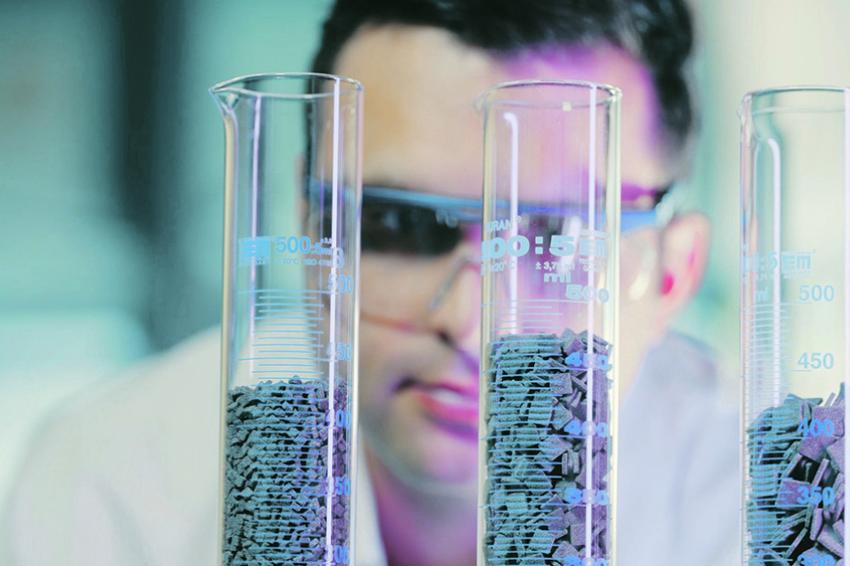The Green Power of Catalysis
Catalysts are Pioneers of Sustainability and Crucial for the Transformation of the Industry
But even more, catalysis is — and has always been — a major enabler of green and sustainable chemistry. With the transformation of the chemical industry to climate neutrality and circularity the importance of catalysis is even increasing. Evonik has been a leader in the catalyst industry for more than 75 years and remains at the forefront of catalyst chemistry. The company has expanded its catalysts business significantly in recent years with the acquisition of Indian producer Monarch in 2015 and US manufacturer Porocel in 2020. The integration of Evonik’s Alkoxides business under the roof of the business line Catalysts further strengthened its portfolio for sustainability and positioned it uniquely for long-term value creation.Michael Reubold asked Sanjeev Taneja, head of Evonik’s Catalysts business line, to explain the importance of catalysts for the green transformation of many industry segments.
CHEManager: Mister Taneja, catalysts pave the way to more sustainable technologies and processes with greater resource efficiency. When has the mega trend of sustainability become a major market and growth driver for the catalysts business?
Sanjeev Taneja: The desire to reduce energy demand and waste while driving up output in petrochemical production has been the focus of catalyst development already for decades — linking back to the function of a catalyst to reduce reaction enthalpy and steer selectivity. Take for example the HPPO process which has been developed in the 1990’s and started commercial scale operation first time in 2008. This direct epoxidation of propylene with environmentally friendly hydrogen peroxide is still a best-in-class example of energy efficiency and elimination of harmful precursors and byproducts. In the existing petrochemical value chains, sustainability and cost efficiency most times go hand-in-hand, as for example the energy saved in a process hits your competitiveness and profitability just as it reduces the carbon footprint of your operations. What has dramatically increased more recently is the number of commercialized or near commercialization processes building on renewable or circular raw materials. But also processes that still depend on fossil feedstocks are striving to become as sustainable as possible.
Our proprietary Excel technology enables refiners to extend significantly refining catalyst life cycles by utilizing Evonik’s global processing footprint in applying this technology. Also, our EcoMax sulfur technology is applied to extend catalyst life cycles for application in critical refining processes to reduce their sulfur emissions. Finally, Evonik’s Rocket platform is applied to recycle and purify various used oil streams using advanced adsorption technology.
The major impact of the industry transformation towards sustainability and climate neutrality is yet to come. Therefore, Evonik Catalysts heavily invests in research and development for recycling, regeneration and sustainability since many years, individually and in cooperations. Innovation is the backbone of our growth expectations, and the strong business impact will show up in the next decade.
Climate neutrality has a lot to do with the shift away from fossil feedstocks. When has the defossilization factor appeared on the horizon of catalysis?
S. Taneja: We cooperate with industrial and academic partners for more than a decade in catalytic and adsorptive defossilization technologies. In recent years, more and more of these technologies prove to be not only ecologically meaningful but as well commercially attractive.
We have seen a tremendous uptick in development projects contributing to the defossilization of value chains over the last five years. Today, almost half of our development projects, which we typically do together with partners on different levels of integrated catalyst and process know-how, focus on novel conversions specifically for defossilized value chains. This includes different steps required for the production of sustainable aviation fuels, valorization of CO2 into chemical building blocks, hydrogen generation and storage technologies, and purification of circular raw materials.
In the life sciences and fine chemicals segment, we see since some years a greatly increased consumer awareness and a corresponding industry push for sustainable products based on natural, renewable, often plant-based raw materials. This applies, for example, to cosmetics, cleaning agents and food supplements.
Catalysts are as individual as the chemical processes for which they have been developed. Given the vast number of markets your business line is serving, is there one common success factor?
S. Taneja: Our main success factor is that we are offering our customers a complete package that goes far beyond pure catalyst supply. A catalyst is at the core of our customer’s process, and any changes to such a complex system requires a holistic approach. We provide innovation from joint catalyst developments to scale-up and commercial production. Comprehensive complementing services like closed-loop concepts for precious metals or rejuvenation of used hydrotreating catalysts further support our customers’ operations. And last but not least, our day-to-day business relationships are characterized by expert customer care. Our customer centricity and efforts to be a problem solver for our customers is greatly appreciated across markets and industries.
“The major impact of the industry transformation towards sustainability and climate neutrality is yet to come.”
In which markets or applications do you expect the greatest growth effects from the sustainable transformation of value chains?
S. Taneja: The largest market with already existing technologies today is in sustainable aviation fuels — SAF. The volume which this market can absorb is huge, given that there are no real alternatives to hydrocarbon combusting systems in the midterm. We also expect several technologies for the production of SAF to coexist for a longer period of time.
Hydrogen generation and storage is another market which has an even higher growth potential, however, relevant catalyst technologies for generation and storage are less clearly defined, so it still remains unclear who will be the main contributors to this new ecosystem.
Beyond this, we see a variety of new conversions from renewable and recycled feed streams to chemical building blocks evolving to decouple typical petrochemical products and polymers from petroleum sources to fulfill regulations on the one hand and customer needs for circularity on the other.
As a co-developer of technologies and custom catalyst manufacturer, we regard ourselves as being uniquely set up to react to new technology ideas and catalyst needs of our partners and are involved in numerous promising co-development projects.
Besides hydrogen storage and transportation, carbon sequestration and storage will rapidly emerge, first in North America, but as well in Europe. A bit later, also carbon dioxide utilization is expected to be an important growth engine.
“We have seen a tremendous uptick in development projects contributing to defossilization value chains over the last five years.”
Could you mention a few success stories of catalysts supporting or enabling the shift from conventional to green chemistry?
S. Taneja: Almost all of our catalysts are enablers for leading-edge processes in terms of resource efficiency and thus, sustainability. We constantly contribute to energy savings and waste reduction, recycling of catalyst materials, and reduction of active metal contents, as well as shift to less hazardous materials. The HPPO process is the ‘greenest’ available route to propylene oxide and is changing the industry landscape sustainably; one application of our hydrogenation catalysts is to reduce chloro-organic byproducts in the production of vinyl chloride, and we manage that with the lowest precious metal content on the market. And as a custom catalyst manufacturer we are supporting methacrylate manufacturer Röhm to launch an entirely new process for MMA synthesis which is currently being built in commercial scale at Bay City, Texas, and will have a lasting impact on the methacrylate value chain in terms of cost competitiveness and sustainability.
A remarkable success in enabling defossilized value chains is the co-development of a catalyst for the Hummingbird process together with Technip. The technology for conversion of ethanol to ethylene is successfully used in the LanzaJet process for conversion of CO2 to jet fuels. With the first demonstration plant starting up this year at Freedom Pines, Georgia, this route will further underline its superiority and take a fair share of the SAF in the coming years.
Evonik has expanded its catalysts business in recent years with the acquisition of Indian producer Monarch in 2015 and US manufacturer Porocel in 2020. Besides the geographic factor, how do the acquisitions of Monarch in 2015 and Porocel in 2020 support the sustainability and the circular economy trends?
S. Taneja: At our site in Dombivli, India, a lot has changed for the better since the acquisition of Monarch, both for the environment and the people, which are also one pillar of ESG – people, planet, profit – we must not forget. While we have established global occupational safety standards right from the beginning, we also have just recently commissioned a zero liquid discharge – ZLD – plant at the site. The new plant reduces the amount of fresh water required for production processes by 65% and turns material that was previously considered waste into saleable products.
The acquisition of Porocel in late 2020 has complemented our portfolio with adsorbents, which play a large role also in the refining of pyrolysis oil, and with catalyst recycling technologies. Additionally, it has boosted our continuous process catalyst manufacturing capabilities and scale, which provides headspace for the commercialization and tremendous growth of our green chemicals and customer projects
At the beginning of 2023, Evonik’s alkoxides business was integrated into the Catalysts business line. What does the addition of the portfolio of homogeneous catalysts mean for your overall offering?
S. Taneja: Alkoxides are an essential catalyst for many applications globally. Many customers, e.g. in the oleochemical or life science industry, are utilizing alkoxides and other products of the business line Catalysts in their processes. Integrating the Alkoxides business into the Catalyst product portfolio strengthens our market position, further expands our innovation pipeline and enables us to differentiate more against our competitors in offering our customers a complete package solution.
Alkoxides are being predominantly used to produce biofuels today, and in the future we are additionally targeting the application of chemical recycling of plastic waste. Hence, the Alkoxides portfolio is another valuable contributor to our business line’s strategy to support and drive the green transformation and to Evonik’s target to generate more than 65% of its sales from NextGen solutions by 2032.
You recently completed the relocation and expansion of the precious metal powder catalyst plant at the Shanghai Chemical Industrial Park — SCIP. How do you expect the Chinese market to develop given the decreasing growth rates of the economy?
S. Taneja: According to recently released economic data, China is projecting a GDP growth of 4.9% in Q3 2023, stronger than the median forecast. Consumption and industrial activities were also more robust than expected, suggesting that the Chinese macro economy may have bottomed out in Q3. A number of new policies and measures have been launched to boost growth in multiple sectors. It is imperative that we leverage the strengths of our local presence: local production, local RDI and technical support as well as the local commercial team that is close to our customers, work closely together to ultimately achieve business growth in the wake of China’s growth.
Local production presence is most important for precious metal powder catalysts, therefore we run five plants across the globe in our production network. The new plant with extended capacity will play an even more important role as part of this network to serve our local, but also global customers.
Where are your major R&D hubs and how do you enable and encourage know-how transfer between them?
S. Taneja: Our R&D hubs are close to customers and markets, this means that we develop catalysts in Asia, Europe and the Americas. We believe that providing timely, customized support to our global customers is only possible with a local presence. However, for Evonik as a global player, know-how transfer is of major importance, not only between regions but as well between the different competence centers. Our innovation activities are mainly organized in cross-functional and multinational project teams, whatever the individual topic demands. This fosters information exchange.Typically, there is no specific need to encourage the teams to share know-how; the colleagues are eager to share their achievements and ask each other for support.
The build out in infrastructure for virtual collaboration during the pandemic makes information sharing potentially seamless. However, for virtual collaboration to be effective it must have a basis in material relationships. These material relationships derive from a mixture of corporate culture, common values, shared focus and are often accelerated by some amount of in-person interaction. Making sure that these strategic aspects are clearly defined, communicated and internalized are critical to ensuring effective collaboration.
What is your overall innovation strategy to develop novel catalysts? Which instruments or tools do you use? Do you have examples?
S. Taneja: The core of our innovation strategy is “close to markets and close to customers”. We need to maintain and further develop an innovation portfolio pipeline with projects of a diversified profile concerning technology readiness level, risk and financial potential profile. Digital tools are everywhere: They penetrate information management like laboratory data management, innovation portfolio management, IP-, competitive- and market analysis, but are as well of significant importance in the design of experiments, simulations or data visualization. This supports our teams in overall efficiency and predictability of laboratory development and scale-up.
The sustainable transformation requires that value chain partners collaborate to develop new approaches to manufacture products. Evonik is a partner in several consortia and R&D cooperations. Could you mention a few of them related to green chemistry or sustainable feedstock/energy generation?
S. Taneja: In recent years we were very active in the Carbon2Chem consortium, which targets converting flue gases from e.g., steel mills into chemicals; or we participated in the SherLOHCk project to develop improved catalysts for LOHC — liquid organic hydrogen carriers — applications. The vast majority of our research cooperations are not publicly funded but between industrial partners, such as the earlier mentioned Hummingbird catalyst development with Technip.
For the effectiveness of catalysts not only the chemical composition is important but also the spatial structure. For instance, you developed micro-structured catalytic metal foams. Could you elaborate briefly on the significance of catalyst structures?
S. Taneja: This is the old mystery of heterogeneous catalysis — both, structure and active center are equally important for the performance of a catalyst. Today we have a broad toolbox of different methods to generate structures and combine the structures with the respective active centers. New technologies to design structures are continuously developed, such as the metal foam catalysts, where we have licensed the underlying technology from Alantum Europe, or such as 3D printing which opens up a completely new toolbox for catalyst applications.
With nickel foam specifically, its unique structure has the advantage of requiring a lot less metal compared to previously used solid catalysts materials, which saves valuable raw materials. Plus the hollow structure makes it extremely lightweight, which allows for lower CAPEX reactor designs.










